Check out my custom vibration dampener
Spinfire Pro 2 Review
Is it the Best Tennis Ball Machine?
We hope you love this article. Just so you know, TennisCompanion may collect a small share of sales from the links on this page to help keep this site running. Learn more.
The Spinfire Pro 2 is one of the best tennis ball machines, which offers excellent features and reliability for a reasonable price.
Although there are less expensive machines on the market, the Pro 2 offers an ideal blend of features and performance at its price point that I find well-suited for a wide range of players.
In this review, I dive deep to share why I chose this machine while exploring all its features, drills, accessories, and more so you can confidently decide if it’s a good fit for your needs.
Article Contents
Click below to jump to a section
Tap below to jump to a section
About Spinfire
Why I Bought the Pro 2
Specs & Overview
Drills
Accessories
Pressureless Balls
Ball Machine Comparisons
New vs. Used
Returns & Warranty
New to TennisCompanion?
Create a free account and explore my latest videos below
About Spinfire
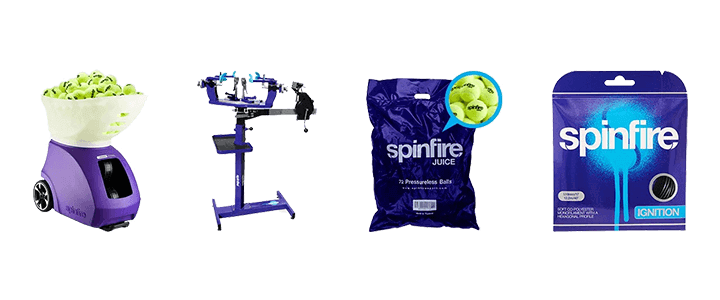
Spinfire is an Australian company backed by tennis players and best known for its Pro 2 ball machine. However, the brand also offers tennis balls, stringing machines, and tennis strings.
Although based in Australia, Spinfire has 32 distributors throughout the following geographic regions:
- United States, Canada, Puerto Rico
- Europe
- Africa, Middle East, India
- Asia Pacific
One of the significant benefits of using one of their local distributors is that shipping and support are more easily accessible for customers, so I’d encourage you to work with the distributor nearest you.
Here’s a link to Spinfire’s global site and their US distributor. Purchasing my ball machine, I worked through the US distributor, and I’ve had an excellent experience with them.
It’s worth noting that Spinfire ships directly to regions without a distributor if there doesn’t happen to be a local option in your area.
Why I Bought the Pro 2
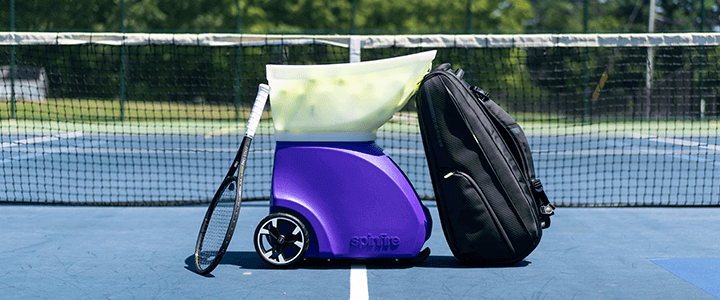
Before we get into the weeds and cover all the details you need to know about the Spinfire Pro 2, let’s talk about the five key areas that convinced me to purchase this machine after having tested and thoroughly researched many others.
Whisper Quiet Internal Oscillation
One of the main reasons I opted for the Spinfire Pro 2 is that its internal oscillation is incredibly quiet. I often play at public tennis courts where there is more than one court, and the last thing I needed was my ball machine to make all sorts of noise while others were trying to enjoy playing tennis on adjacent courts.
The machine’s loudest noise is firing the ball, which is quieter than me hitting the ball with a racquet, so I can confidently show up at a court knowing I won’t offend anyone nearby. Unfortunately, this is not the case for all tennis ball machines.
Simplicity
There are more than a handful of excellent ball machines on the market, but many of them aren’t super intuitive to operate. I’m not suggesting others require rocket science, but the Spinfire Pro 2’s operation is logical and doesn’t come with overwhelming options.
Instead, it has just what you need and nothing more, which I think is ideal for 98% of players. In my opinion, anyone looking for super complex drilling is better off finding a hitting partner.
Disguised Ball Delivery
Random ball delivery isn’t as effective when the entire machine oscillates or rotates to feed because you know exactly where it will throw the ball. The Spinfire Pro 2 helps with this by having the throwing wheels rotate within the machine, making it much more challenging to pick up where it will throw the next ball.
Although you can detect some movement, the throwing wheels are black, and it’s dark inside the machine, so it’s more difficult to gain a feel for where the next ball will land.
Physical Lightweight Remote
Once I fill up the ball machine’s hopper, I don’t want to run back to the other side of the court to adjust settings – it’s a pain in the butt and a waste of time. The Spinfire Pro 2 includes an intuitive remote, while others require you to purchase it separately.
Furthermore, I prefer a tiny, lightweight remote that can fit in my pocket vs. using an app on my phone. Although having an app on your phone might seem practical, it’s more hassle than helpful. Phones these days are too heavy to keep in your pocket while playing comfortably, and once your phone sleeps, you have to wake it up to jump into the app and make a change, which is unnecessarily cumbersome.
Compact & Easy to Transport
Most of us who buy ball machines will need to transport them, which was the case for me. Even if you live at an apartment complex with tennis courts, you’ll likely still need to bring it to the court when you want to use it, so the lighter and easier to carry, the better. The Spinfire Pro 2 fits the bill and has the option for an external battery to make the machine even lighter if needed.
Specs & Overview
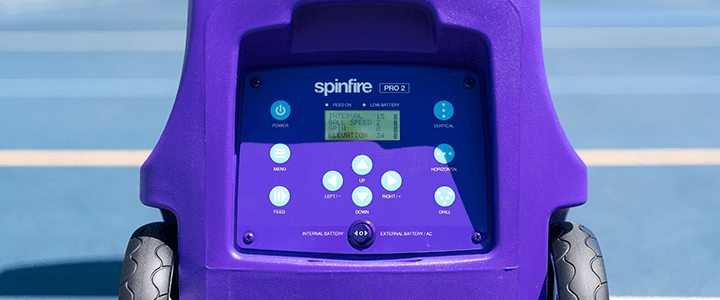
Ball machines are more sophisticated than ever, and the Spinfire Pro 2 offers excellent versatility for such a compact machine. Here is a table outlining key specifications.
| Feature | Details |
| Oscillation | One-line, horizontal, and vertical |
| Speed | 20 to 80 mph |
| Feed Rate | 2 – 15 seconds |
| Spin | Topspin, backspin |
| Elevation | 5 – 60 degrees, electronic |
| Ball capacity | 150 |
| Power | Battery, plug-in, battery + plugin |
| Play Time | 4.5 – 8.5 hours* |
| Weight | 40 pounds (without battery) |
| Basic charger | Included |
| Fast Charger | Optional |
| Remote | Included |
| Warranty | 2 – 5 years** |
*With lithium battery
**Optional 5-year available
For added context and information, I discuss each of these in greater detail below.
Speed (20-80 mph)
If you’re buying a ball machine, the speed it can feed is likely a consideration. Intermediate and advanced players will want to increase the speed to replicate the type of heavy ball they’re used to seeing from an opponent while having the flexibility to tone it down. For example, to work on finesse shots at the net.
However, if you’re learning, you’ll want the ability to reduce the speed to make it easier to field balls. On the high end, eighty miles per hour is fast. If you’re concerned that it’s not fast enough, I think you’ll be more than satisfied with the pace it can bring. On the lower end, twenty miles per hour is plenty slow, even for younger kids.
Spin (21 levels)
Spin is useful for replicating the types of shots you’ll see from an opponent in competition while practicing. The Spinfire Pro 2 offers ten levels of topspin (+1 to +10), backspin (-1 to -10), and 0 for no spin, giving you greater flexibility to customize how the machine delivers balls to you.
Once again, these settings are more than sufficient. Set the spin level lower to replicate a slice shot or increase it to bring heavy topspin that won’t disappoint on either end of the spectrum.
Feed Rate (2-15 seconds)
The feed rate refers to the number of seconds that pass between balls when the machine is feeding. Faster feed rates are fantastic for replicating a high-intensity match and increasing your heart rate for an excellent workout.
Lower feed rates, on the other hand, provide you with time to reset between shots and are ideal for practicing. I often use lower feed rates in conjunction with cones where I must complete a footwork drill between shots for a more intense workout.
Elevation (5° to 60°)
Changing the elevation enables the machine to feed short balls that fly just over the net as you might do for practicing an approach shot or higher balls that replicate a lob when hitting overheads. Once again, the highest and lowest settings are more than sufficient.
Ball Capacity
The Spinfire Pro 2’s hopper can fit up to 150 tennis balls, which is an ideal range and more than enough balls to prevent you from picking up too many times during a session on the court.
I usually fill it up halfway because that’s roughly the number of balls that fits most standard ball hoppers, and I find that plenty sufficient.
Power
The Spinfire Pro 2 has three power options: battery, plug-in, and battery + plug-in. For me, battery power was essential.
Furthermore, if you opt for a battery option, you can choose between an internal or external battery. For my first machine, I opted for an external battery so that it was easier to carry up and down a flight of stairs, but I changed it on my second machine because the newer lithium batteries are lighter.
The external battery is also an excellent option if you want to keep your ball machine in the trunk of your car and only bring your battery into the house, so you don’t have to lug it back and forth.
Play Time
According to Spinfire, the battery will get you three to eight hours of play. When my battery was new, I never pushed the machine past four hours, and the battery always held up.
Unfortunately, batteries don’t last forever, so as time passes, expect play time to decline. I didn’t notice any change for the first year and a half, but once I hit that mark, my battery wouldn’t last much longer than two hours, so I replaced it around the two-year mark.
Spinfire offers a lithium battery with better play time performance and shorter charge times. If you’re an instructor who needs more life out of your battery, then it’s an excellent investment.
Weight
The Spinfire Pro 2’s weight varies depending on your selected power option. Here are the measurements to keep in mind:
- Machine with external battery: 40 lbs (18 kg)
- Machine without battery, plug in: 40 lbs (18 kg)
- Machine with internal SLA battery: 53 lbs (24 kg)
- Machine with internal lithium battery: 47 lbs (21 kg)
- External SLA battery: 13 lbs (6 kg)
- External lithium battery: 7 lbs (3 kg)
- Plastic ball hopper: 4 lbs (1.8 kg)
If weight concerns you, I’d encourage you to opt for the external battery, which will reduce how much you have to lift to get it in and out of a car. I don’t expect most players to struggle with the 47 lb weight because the machine is compact, and handles make lifting relatively easy, but you’ll have to go with your instinct.
As a bonus, the hopper comes off and flips upside down on the machine for transport. It weighs 4 lbs (1.8 kg), so you can take it off to shed a little extra weight when lifting.
Chargers
There are two batteries available to you when purchasing, sealed lead acid (SLA) and lithium. If you buy the SLA battery, you can buy a standard or fast charger. Here are the charging times:
- Standard SLA charger: 11 hours
- Fast SLA charger: 5 hours
If you opt for the lithium battery, you’ll automatically get a fast charger, which cuts charging time to 5 hours, which is excellent considering it’s a longer-lasting battery.
If you opt for the SLA battery, the standard charger is plenty sufficient as long as you plug the battery in when you get home, as it will charge with plenty of time to spare overnight. However, if you teach or buy the machine for a club, you may find that the fast charger is beneficial for speedier charging between uses.
Remote
The Spinfire Pro 2’s remote is excellent, and its “featherweight” description is accurate. Here are its specs, which is roughly the size of a credit card, just thicker:
- Height: 3.43 in (87 mm)
- Width: 1.97 in (50 mm)
- Thickness: 1/4 inch (7 mm)
- Weight: 24 g
It’s barely noticeable in your pocket while playing, comes with a battery, has excellent range, and is easy and quick to use.
Warranty (2 or 5 years)
The Spinfire Pro 2 comes with a two-year warranty, but you can extend it up to 5-years for an additional $199.
The SLA batteries don’t last as long, so under both warranties, this battery is only covered for six months. Meanwhile, Spinfire covers the lithium battery for the entire warranty length, which is a nice bonus.
Keep in mind that a replacement SLA battery costs $99, so although you’re paying a premium for the lithium battery, you can expect fewer issues. Plus, it lasts longer, charges faster, and you get the added benefit of the full warranty period.
Any premium ball machine like the Spinfire Pro 2 is a sizeable purchase, so the warranties are a bonus to protect your investment. For reference, I purchased the extended warranty, but I haven’t had a single issue with mine since buying it, so that’s worth keeping in mind.
Drills
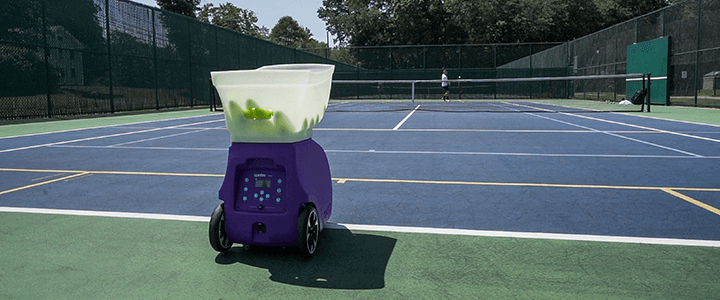
One of the benefits of modern tennis ball machines is that players can use them to drill and improve their skills. Although the Spinfire Pro 2 doesn’t offer the most extensive drill selection on the market, I find their product to be more than sufficient, providing plenty of variety. The following are the out-of-the-box drills the machine offers.
Single-Line
A single line drill is one where the machine fires the ball on a single predetermined path. For example, if you want the ball to feed cross-court forehands continuously, it can do that. In essence, any shot you can think of you can practice over and over with the Spinfire Pro 2.
As simple as this drill is, it’s one of my favorite because it allows me to gain repetition and build consistency with a specific stroke. If you’ve ever played a match and one of your shots let you down, you may have wanted to get on a court and repeat the shot a hundred times to regain your feel. If so, this type of drill is perfect for you.
Alternatively, I love using single-line drills to practice shots I don’t hit often but would like to improve so I can execute under pressure, such as a drop volley. I use this setting more than any other.
Two-Line
The two-line drill will alternate firing tennis balls from left to right, which is ideal for alternating between forehands and backhands. It also works well up at net for alternating between volleys. It has three settings that allow you to increase the width of feeds, starting with narrow, increasing to medium, and maxing out at wide.
When using this drill, you can adjust the feed rate to have enough time to get to each ball, depending on the width you set. The wide setting is challenging, firing tennis balls near the singles sidelines.
This drill is excellent if you’re looking for equal practice from both sides of the court with predictable feeds from one side to the next.
Horizontal Random
Horizontal random is one of my favorite drills for practicing groundstrokes, which fires tennis balls randomly along the baseline. It’s the same as the two-line drill, but balls are fired at varied locations that are unpredictable.
I find this works well to replicate a live-hitting experience where you don’t know which side of the court your opponent will hit. Like the two-line drill, you can set the width of the machine’s feeds to narrow, medium, and wide. Increasing the feed rate is an easy way to make it more challenging.
Vertical Random
The Spinfire Pro 2 will feed short and deep balls at random using the vertical random drill.
To use this drill, you first adjust the speed, spin, and elevation so that the machine fires a short ball at the desired location. Once set, you can activate the drill, and it will feed a short ball followed by a deeper ball as it adjusts the elevation back and forth by four degrees.
This drill is perfect for practicing a groundstroke followed by an approach shot or a volley. When I use this drill to follow up with a volley, I usually increase the feed rate to replicate the faster reaction time required in a live match scenario.
Horizontal & Vertical Random
Activating horizontal and vertical random will provide you with the closest simulation to live match play.
Balls will feed from side to side, but you’ll also have to field shorter and deeper balls, just as you would with an opponent. Although many players will gravitate to using this drill for groundstrokes, I also like it for volleys because it forces you to volley at varying heights.
Again, set your short ball’s speed, spin, and elevation before activating horizontal and vertical random together. Otherwise, you may find some balls fly long.
Accessories

Along with the ball machine, Spinfire offers a handful of accessories that you might find practical for your needs.
Sealed Lead Acid (SLA) & Lithium Batteries
If you opt for the battery-powered machine, the SLA battery is the one that it will come with by default at no extra charge.
The lithium battery is Spinfire’s premium offering, which overall is a better battery, but it costs $299 extra, so you need to weigh the advantages. Here’s a table that compares the two batteries to help you decide which is best for you and your needs.
| Battery | Standard | Lithium |
| Running Time | 3 – 8 hours | 3.5 – 8.5 hours |
| Weight | 14 lbs | 7 lbs |
| Standard charge time | 11 hours | n/a |
| Fast charge time | 4 hours | 5 hours |
| Lifetime | 500 charge cycles | 2000+ |
| Warranty | 6 months | 2 or 5 years* |
| Maintenance | monthly charging | no monthly charging** |
| Voltage | drops slightly | doesn’t drop*** |
*It coincides with the full length of warranty you select.
**If you don’t charge the SLA battery monthly, you’ll diminish its lifetime. The lithium battery doesn’t require monthly charging.
***The top speed the machine can feed drops slightly with the voltage.
Overall, the SLA battery is sufficient, but for an extra expense, the lithium battery has its advantages.
When I hit the court, I want to travel as light as possible, and cutting the battery’s weight in half is a win, especially when opting for the internal option. I also appreciate how the battery doesn’t require monthly charging to maintain its lifespan. If you go through a period where you don’t use your machine often, you could kill your SLA battery if you don’t remember to charge it. Finally, I appreciate that it has a lengthy warranty even if you don’t opt for the extended option.
Although it will take time, the lithium battery will roughly pay for itself if you use your machine regularly. The lithium battery costs $299, but you’d need four SLA batteries to get the same number of charge cycles.
The first SLA battery comes with the machine, but each additional battery costs $99, and you’d need to buy three of them to get the same performance as the lithium, which would cost $267. So for $32 more, you could get the lithium and deal with fewer hassles. Of course, that assumes you don’t accidentally kill an SLA battery at one point.
Helpful Tip
My second SLA battery never provided maximum play time and, within three months, wasn’t lasting longer than an hour. I consistently charged it and used the snooze feature to conserve battery when not hitting. I reached out to Spinfire because I was in the warranty period, and they replaced it without issue.
If you also appreciate the faster charging time, it’s an easier choice because that will cost you $99 for the SLA battery, while the lithium battery only comes with a fast charger.
Overall, the SLA battery works well, and it’s what I purchased the first time because it was the only option available. Still, from my experience, I think the lithium is worth the added cost.
As a side note, the SLA battery Spinfire uses with their machines is common, so you can purchase it elsewhere if you’d like. Here are the details you’d want to search for to order it from another supplier:
- Specs: 12V, 20AH, 6kg/13lbs
- Dimensions: 181.5mm (L) x 77mm (W) x 167mm (H)
- Terminal Type: T3 (post) or screw down
You can also use an 18AH and 22AH SLA battery with your Spinfire machine, with the former being roughly a pound lighter and the latter being one pound heavier than the 20AH.
Standard & Fast Battery Chargers
You have two options if you purchase your machine with the SLA battery. For no extra charge, it comes with the standard charger, which will fully charge your battery in 11 hours. Alternatively, you can pay $99 extra for a fast charger, which brings the charging time to four hours.
If you go with the SLA battery and don’t have a strong use case for the fast charger, then I don’t think the added expense is worth it. I always charge my machine at night, so I never needed it to be faster than the standard charger.
If you opt for the lithium battery, it only comes with the fast charger, which will get you a full charge in four hours. At its price, I’m glad Spinfire includes the fast charger with this battery.
AC Adapter to Plug it In
I expect most people will buy the Spinfire Pro 2 with a battery, but if you want the battery and the option to plug your machine in, then the AC adapter’s price of $149 feels reasonable.
The AC adapter is a solid option if you have a court at home or live in an apartment complex with power near the tennis courts. I don’t have a place where I can plug in my machine, so it was never a consideration. However, even if I did, I think I’d still opt for the battery power because it gives me the flexibility to bring the machine wherever I want.
Cover
For $49, you can buy a cover for your Spinfire machine, which can be helpful to keep it free of dust and debris when you’re not using it.
I keep my machine inside my garage on a cart and don’t use a cover, and haven’t had any issues, so whether or not you opt for a cover depends on where you intend to store it. It’s worth noting that I vacuum my machine inside and out every few uses.
Regardless of what you do, I’d strongly encourage you to store yours inside, even if you have a cover to protect your investment.
Bonus: Cart for Practicing Returns
The return is one of the game’s most important shots to become proficient at, so when I bought my machine, I was determined to find a cost-effective solution.
Enter a basic utility cart like this one from Olympia, which fits the Spinfire Pro 2 on top with room to spare. Once positioned, wheel the ball machine just behind the service line toward the center. Next, set the Pro 2 to its lowest elevation, then adjust the speed, spin, and direction until balls fire inside the service box.
Although you won’t be able to use the machine’s top speed when practicing returns because they’ll fly long, it’s still excellent for getting reps in. The utility cart is also a convenient way to bring all your gear to the court in one trip.
If you buy a utility cart, ensure it’s 32 inches high, 16 inches wide, and 26 inches long so that the machine will fit.
Just so you know, TennisCompanion may collect a small share of sales from the links in the above section to help keep this site running. Learn more.
Pressureless Balls

If you want to learn more about pressureless tennis balls, I’d encourage you to check out my guide on the topic.
At a high level, quality pressureless tennis balls are considerably more durable and long-lasting than their pressurized counterparts. Although they tend to appear slightly heavier and have a mildly different feel and sound, they work exceptionally well with ball machines.
I’ve tried both with my machine, and it’s the only type of tennis ball I recommend for use with the Spinfire Pro 2. Standard pressurized balls get chewed up quickly and will not last.
You can use any pressureless tennis ball with your machine, but there are only a handful of premium options I’d recommend, and Spinfire’s are some of the best.
Depending on where you live, you may come across a few different offerings; here’s what you can expect.
Spinfire Juice
Spinfire Juice are high-quality premium tennis balls with thicker rubber cores that don’t require internal pressure. The ball and felt are extra durable to stand up to your machine’s throwing wheels, and they deliver fantastic performance and a consistent bounce for months.
Due to their firmer nature, these balls feel heavier, but comparing the weight of each of Spinfire’s balls, they’re right on par with mainstream pressurized balls, so it boils down to feel. Furthermore, these balls fly fast and offer excellent grip for topspin. If you’re looking for maximum durability, these are your best bet and my top pick.
- Spinfire Juice Avg. Weight: 57.9 grams
- Penn Championship Avg. Weight: 58.3 grams
Spinfire Touch
Pressureless balls are notoriously firm, which is part of where they get their durability. Recognizing this, Spinfire offers a softer, more forgiving option with the Spinfire Touch balls.
I find these to feel softer, more like a standard pressurized tennis ball, while offering excellent durability. They also play noticeably slower than the Spinfire Juice, so that’s a tradeoff.
When hitting with them, you might notice a louder pop sound, similar to what you hear when a standard ball goes dead, but it doesn’t impact their playability, so unless you’re super picky about that, it’s negligible.
These are an excellent option if you’re looking for a softer, pressureless tennis ball that’s easier on your arm. Otherwise, my recommendation would be to opt for the Spinfire Juice.
- Spinfire Touch Avg. Weight: 58.4 grams
- Penn Championship Avg. Weight: 58.3 grams
SetPoint Pulp – US, Canada
If you’re in the US or Canada, your only option from Spinfire without incurring high shipping charges from Australia is SetPoint Pulp, which are excellent pressureless tennis balls.
They’re similar to the Spinfire Juice, perhaps subtly less firm with more compact felt, so I find these to fly the fastest of the three. Outside of that, I find them to be every bit as durable as the Spinfire Juice and Touch, so they’re an excellent option.
- SetPoint Pulp Avg. Weight: 58 grams
- Penn Championship Avg. Weight: 58.3 grams
General Pressureless Tennis Ball Notes
At first, most pressureless balls will feel a bit firmer, but they break in after a few uses and then remain surprisingly consistent for months, so keep that in mind when first hitting with them.
Although Spinfire’s are lighter than Penn Championship tennis balls, a top seller in the US, they tend to feel heavier. In my experience, that’s because pressurized tennis balls have more spring or pop to them, and they’re less firm, so they feel lighter.
As far as wear goes, you’ll notice the felt starts to compact on pressureless tennis balls after a while, which means they don’t have as much bite for generating topspin as they age, but for practice, I never have found it to be a big deal.
Outside of that, they can last well over a year, depending on your frequency of play.
Ball Machine Comparisons

Although Spinfire offers an excellent ball machine, they’re not the only company that sells them, so let’s review three other machines that community members frequently asked about for comparison.
To start, here’s a table with a high-level comparison. Scroll left to right to see all data.
| Brand | Machine | Price | Physical Remote | Total | Play Time | Weight | Weight With Battery | Capacity | Speed | Rate | Return | Warranty |
| Spinfire | Pro 2 | $2,399 | $0 extra | $2,399 | 3 – 8.5 hrs | 40 | 47 | 150 | 20-80 | 2-15 | 30 day | 2 – 5 years |
| Spinshot | Plus 2 High Spin | $2,199 | $100 extra (limited) | $2,299 | 2 – 3 hrs | Unknown | 37 | 120 | 18-68 | 2-10 | 30-day | 2 year |
| Lobster | Elite Four | $2,099 | $249 extra | $2,348 | 4 – 8 hrs | Unknown | 44 | 150 | 10-80 | 2-12 | 30 day | 2 – 5 years |
| Silent Partner | Scoop Series – Smart | $2,299 | $0 extra | $2,299 | Unknown | 40 | 50 | 300 | 10-95 | 0-10 | 30 day | 1 year |
Overall, the machines are similar in many ways, so I provide some points of comparison in the following sections.
Spinfire Pro 2 vs. Lobster Elite Grand Four
Lobster makes excellent tennis ball machines that are worth considering, but there were a few reasons I opted for Spinfire.
One of the main reasons is that I prefer internal oscillation, which is much quieter and disguises the feed of the ball in random modes. I also like the Spinfire Pro 2’s form and color and that they position the handle underneath the machine rather than behind it – it’s a cleaner look.
Finally, I appreciate the simplicity of Spinfire’s offering. Rather than selling several models, they offer two machines, and it’s easy to decide between them. If you’re in the US, it’s even easier because they only sell the Spinfire Pro 2 in the states.
However, if you’re looking for some pre-built drills, Lobster’s Elite Grand Four and above models provide an advantage.
Spinfire Pro 2 vs. Silent Partner Scoop Series Smart
Silent Partner is another quality offering, but I also prefer the form, color, and handle location of Spinfire’s machine. I found Silent Partner’s handle location to be a bit awkward inside the hopper, which gets covered by balls, making it tricky to move when needed.
Finally, I prefer the thinner profile remote with Spinfire’s machine, which I use heavily and keep in my pocket.
If you’re looking for extra drills and programable options, then the Silent Partner Scoop Series Smart has an edge, but I didn’t feel like those were necessary for the kind of practice I wanted.
Spinfire Pro 2 vs. Spinshot Plus-2 High Spin
Another brand you’ll likely stumble across in your research is Spinshot Pro 2, which is a popular option and an excellent machine.
However, one of the biggest selling points for me with the Spinfire over the Spinshot is the physical remote that’s lightweight and easy to carry in your pocket while hitting. Spinshot has a simple wrist remote that only starts and stops the machine and toggles between drills. Their app is full-featured, but I wouldn’t want to carry my phone while playing, so that’s a non-starter.
Like Lobster and Silent Partner, Spinshot is more robust regarding drills, but that wasn’t a key consideration for me.
New vs. Used

Periodically, I’ve seen a Spinfire ball machine listed on one of the many marketplaces for selling used goods online, but it’s pretty rare, so you’ll have to be patient. Here are the places that I’d encourage you to look:
- eBay
- Craigslist
- Facebook Marketplace
- OfferUp
- VarageSale
In my experience seeing these machines listed, most owners are selling them for a premium that’s not too far off the list price because new models aren’t released often, and functionality remains relatively consistent.
The Spinfire Pro 2 is a reliable machine, so if you can get your hands on one for a solid deal, it could work out great. If you consider purchasing a used machine, keep in mind that the warranty will not transfer despite what the seller might tell you.
Returns & Warranty
When buying an expensive ball machine, it pays to know how you’re protected with refunds and warranties before purchasing. Here’s what you can expect from Spinfire.
Returns
If you buy a Spinfire Pro 2 ball machine, I think you’ll love it and have zero desire to return it as it exceeded my expectations.
With that said, things happen, and you may find yourself in a situation where a return is warranted. If so, Spinfire Offers a 30-Day Money Back Guarantee. That’s one of the best in the business. All you have to do is call them within 30 days of receiving the machine to organize a refund, then ship it back within five days.
Spinfire won’t refund shipping charges when issuing a refund; you’re also responsible for shipping it back. Furthermore, there’s a 10% restocking fee, which is increased by $120 if you use it on clay, so I’d encourage you only to use it on hard courts the first few times.
Keep in mind that you need to return it in the original box, so don’t throw that away after opening it. Plus, if you ever need to send it in for repairs, the box will come in handy, so break it down and store it. Also, the machine needs to be in pristine condition for a return, so take good care of it during your first few uses.
Finally, they’ll only refund tennis balls if the plastic package they came in is unopened, so you’ll most likely keep these if you initiate a refund.
Warranties
When you purchase a Spinfire Pro 2 ball machine, you get a two-year warranty, which you can extend to five years for an extra $199.
As you’d expect, the warranty covers breakdowns or issues you run into with the machine’s ability to operate caused by everyday use, not by abuse, neglect, accident, or unauthorized repairs and modifications of the machine. If you run into an issue, I’d encourage you to contact Spinfire, as troubleshooting can sometimes get the machine back up and running without replacing parts.
Also, you’ll have the option to try and replace the parts yourself with their team’s guidance to avoid shipping the machine back, which you’ll be responsible for if necessary.
All in all, I feel like Spinfire’s warranty is generous, and if you’re the type of person that likes to protect their investment, you have the option to extend it further. That’s what I did, but I haven’t had any issues over the three years I’ve owned it.
Should You Upgrade?
If you’re a current user of the Spinfire Pro 2 v1, you may have stumbled upon the latest v2 machine and wonder whether you should upgrade yours for the latest features.
Here are some of the changes in the order of how I perceive their importance or usefulness.
- Carousel: the carousel that gathers balls in the hopper ensures all balls are fired and works significantly better than the last design.
- Shape: the ball machine now has a smaller footprint, making it easier to carry and store.
- Extra Handle: when you invert the hopper, there’s now an extra location toward the top where you can pick up the machine, which is a bonus for picking it up without bending too far down.
- Larger Wheels: going over surfaces like gravel is now easier, and the wheels are more robust and sturdier.
- Oscillation Updates: Horizontal and vertical oscillation modes are now random, where it was previously predictable, and horizontal now can fire narrow instead of only being able to fire medium or wide.
- Charging Port: it’s now accessible with the hopper inverted, so you can charge your machine without removing it. This feature is only a plus if you have an internal battery, but it’s nice to have in that case.
- Master Switch: instead of under the machine, it’s now more conveniently located at the control panel. On a few occasions, I accidentally turned off the master switch while transporting the machine and thought I had killed it. It didn’t take long to figure out, but it would have been way more apparent with the new location.
- Control Panel: Spinfire recessed the LCD for better visibility, and it’s overall more polished looking.
- Remote Pocket: you can slip the remote into a pocket directly below the control panel, which is convenient for storing. I keep mine in my bag so it’s protected and I don’t misplace it.
- Smaller Mouth Size: the hole where balls fire from is now smaller, making it less likely to hit a ball inside.
Although Spinfire changed a lot, and I appreciate the enhancements, I think most people would find it hard to justify upgrading because the prior model is functionally very similar.
With that said, if I were on the hunt for a used machine, these changes would convince me to buy the latest model. That’s because most of the used Spinfire’s for the foreseeable future will be the Pro 2 v1, and the nominal savings of a used machine likely isn’t worth missing out on the new features.
Regardless of where you stand, there’s no doubt the Spinfire Pro 2 v2 is their best machine by a long shot.
Is It the Best?
The Spinfire Pro 2 is undoubtedly one of the best tennis ball machines on the market. For me, it tops the list, and it hasn’t disappointed, but my needs aren’t necessarily consistent with yours. For example, if you strongly believe programmable drills are a must, then the Spinfire Pro 2 isn’t going to be the machine for you.
Regardless of your choice, I hope my review helped shed some light on what to expect from Spinfire’s Pro 2. If you have questions about this machine or others, drop a comment below. I’d love to hear from you.
Home > Ball Machines > Spinfire Pro 2
Play Better Tennis
Improve your game alongside our community of tennis players
Why join?
Discussion Boards
Join the conversation with other members of the community.
5 Point Friday
Read our weekly recap of the 5 most interesting things we dig up in tennis.
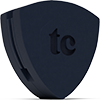
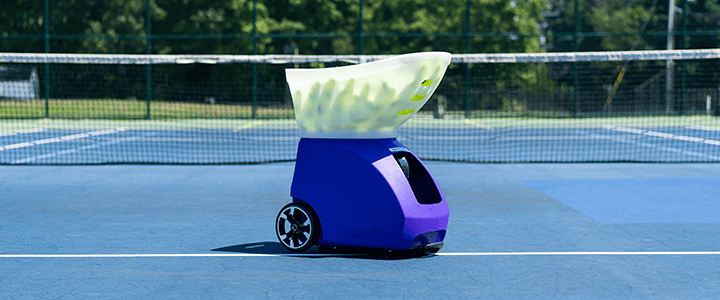

Leave a Reply
Want to join the discussion?Feel free to contribute!